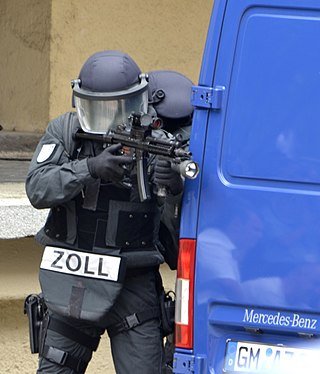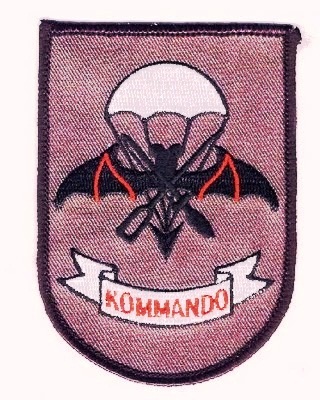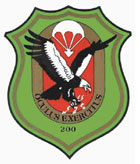
Sportgemeinschaft Dynamo Dresden e.V., commonly known as SG Dynamo Dresden or Dynamo Dresden, is a German association football club based in Dresden, Saxony. They were founded on 12 April 1953 as a club affiliated with the East German police and became one of the most popular and successful clubs in East German football, winning eight league titles.

Landespolizei is a term used to refer to the state police of any of the states of Germany.
Polizei is the German word for police. Police in Germany, Austria and Switzerland consist of different agencies. It might refer to:
Spezialeinsatzkommando are police tactical units of each of the 16 German State Police forces. Along with the Mobiles Einsatzkommando (MEK), Personenschutzkommando (bodyguards), and the Verhandlungsgruppe, they are part of the police Spezialeinheiten of each state.

The P30 is a polymer framed semi-automatic handgun by Heckler & Koch, available in 9×19mm Parabellum and .40 S&W.

The Bavarian State Police is the state police force of the German state of Bavaria under the umbrella of the Bavarian Ministry of the Interior. It has approximately 33,500 armed officers and roughly 8,500 other civilian employees.

The Border Troops of the German Democratic Republic was the border guard of the German Democratic Republic (GDR) from 1946 to 1990.

The Unité Spéciale de la Police (USP) is the police tactical unit of the Grand Ducal Police that was created in Luxembourg in 1999. It is tasked with responding to especially dangerous situations such as hostage rescue operations, arrests of dangerous individuals, bomb threats, and dignitary protection duties. The unit trains abroad with comparable units, in particular the Belgian DSU and German SEK.

The Ministry of National Defense was the chief administrative arm of the East German National People's Army. The MND was modeled on the Ministry of Defense of the Soviet Union. The headquarters of the Ministry was in Strausberg near East Berlin. The Guard Regiment Hugo Eberlein provided security and guard services to the Ministry. The Ministry also had its own publishing house, Military publishing house of the German Democratic Republic.

FC Mecklenburg Schwerin is a German football club based in Schwerin in Mecklenburg-Vorpommern. The club was formed from a merger in 2013 and competes in the fifth tier NOFV-Oberliga Nord. The club plays its home matches at the Sportpark Lankow. FC Mecklenburg Schwerin also has gymnastics squads and an Esports department.

The Zentrale Unterstützungsgruppe Zoll (ZUZ) is the police tactical unit of the German Customs Service (Bundeszollverwaltung) and subordinate to the German Customs Investigation Bureau.

The Heckler & Koch VP9 is a polymer-framed semi-automatic striker-fired handgun. The VP designation in the name refers to Volkspistole, which translates to "people's pistol", while SFP stands for "striker-fired pistol". The 9 stands for the caliber designation of 9 mm. The VP9 is the third striker-fired pistol that HK has produced. A variant of the VP9, the VP40, is chambered for .40 S&W; the VP40 is known as SFP40 in Europe and Canada.

Wolfgang Albers is a German jurist. From 1 October 2011 to 8 January 2016 he has served as chief of the Cologne police.

Eiche is a locality (Ortsteil) of Potsdam with 4480 inhabitants (2008). It was incorporated into the city of Potsdam in 1993.
Kommerzielle Koordinierung, or "KoKo" for short, was a secret commercial enterprise in East Germany, run by Stasi officer Alexander Schalck-Golodkowski.

The Fallschirmjägerkompanien B1 were specially trained units of the German Bundeswehr and the predecessor of the current German army's special operations unit Kommando Spezialkräfte.
Saxony State Police is a state law-enforcement agency in Saxony, Germany. It is subordinate to the Saxony State Interior Ministry. The Chief of State Police (Landespolizeipräsident) is Horst Kretzschmar and the political head is the Minister for the Interior in Saxony Roland Wöller (CDU).













